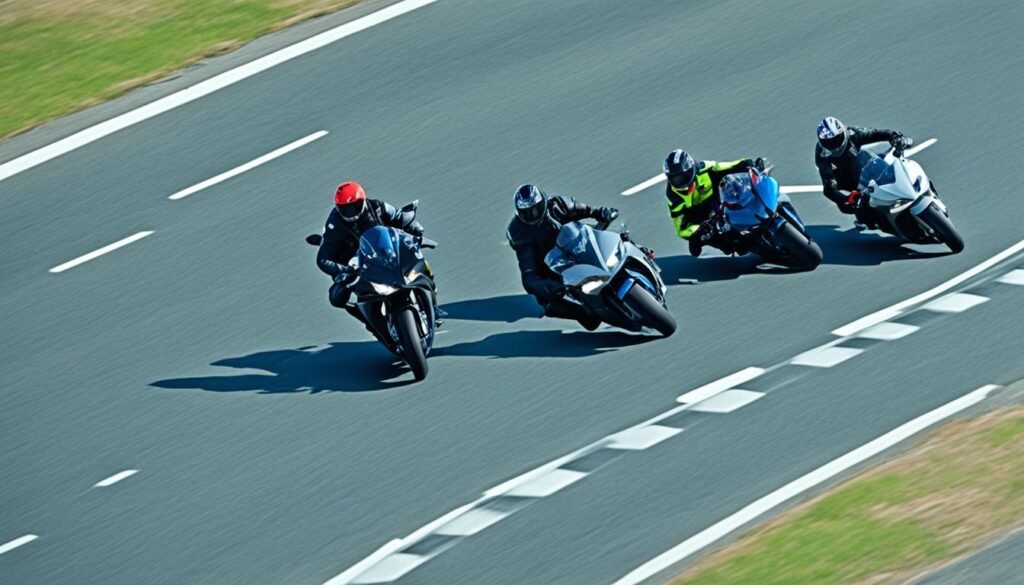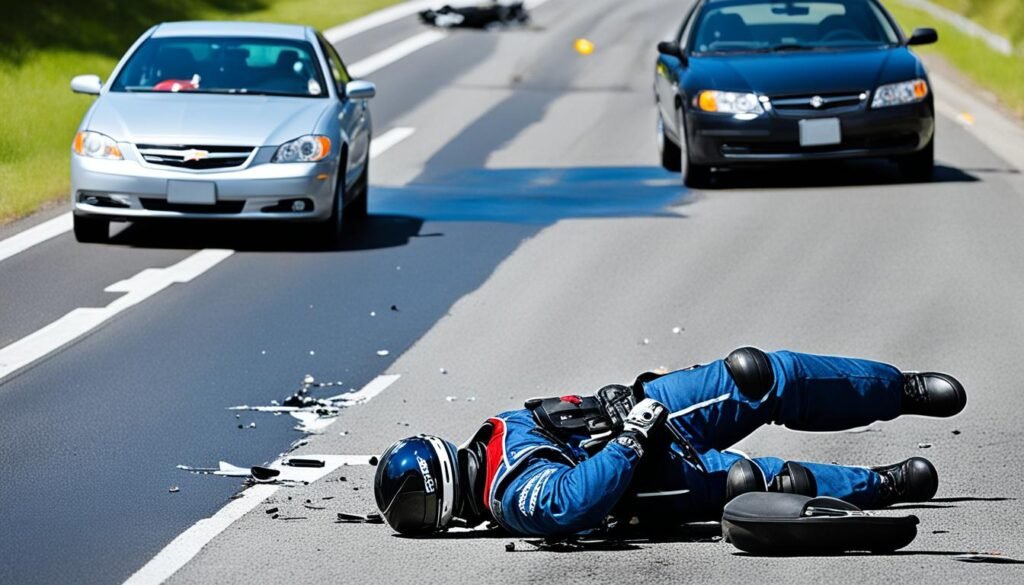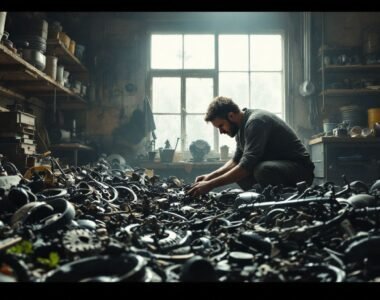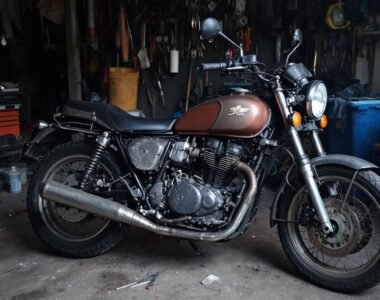
Drivers need to be extra careful around motorcycles. Motorcycles are more likely to get into accidents and get hurt. In 2021, the Insurance Institute for Highway Safety found that 6,084 motorcyclists died, making up 10.5% of all traffic deaths.
When driving near motorcycles, there are key things to avoid. Don’t drive recklessly, like making sudden lane changes or tailgating. Motorcycles need more time to stop and are less stable than cars. Also, always check your blind spots before moving lanes to avoid hitting a motorcycle.
Don’t text or talk on the phone while driving near motorcycles. These actions can lead to serious accidents. Keep your eyes on the road and your hands on the wheel at all times.
Being careful, keeping a safe distance, and staying alert helps make roads safer for motorcycles. Gas Gas motorcycle wreckers support motorcycle safety and sustainability.
Key Takeaways
- Avoid reckless driving behaviors around motorcycles, such as sudden lane changes and tailgating.
- Always check your blind spots before changing lanes to ensure you don’t collide with a nearby motorcycle.
- Refrain from distracted driving, as it can have devastating consequences for both you and the motorcyclist.
- Maintain a safe following distance to allow for adequate braking and reaction time.
- Exercise caution and awareness when sharing the road with motorcyclists to promote safety for all.
Understanding the Vulnerability of Motorcycles
Motorcycles are thrilling to ride but are more vulnerable than cars. Their design makes them more prone to motorcycle vulnerability. They have less protection and stability, raising the risk of severe injuries in crashes.
Motorcycles Offer Less Protection and Stability
Motorcycles don’t have the strong frame or enclosed cabin of cars. This leaves riders exposed to impacts, making them more likely to get seriously hurt. They are also less stable than cars, hard to control in bad weather or when dealing with road hazards.
Increased Risk of Severe Injuries in Collisions
Motorcycles are naturally more motorcycle vulnerable and offer less protection. This means riders face a big risk of severe injuries if they crash. In motorcycle accident risks, injuries can be severe, like traumatic brain injuries, spinal cord injuries, and complex fractures. These injuries can have long-lasting effects on riders.
| Injury Type | Frequency in Motorcycle Accidents | Severity of Injury |
|---|---|---|
| Traumatic Brain Injury | 40-50% | High |
| Spinal Cord Injury | 20-30% | High |
| Complex Fractures | 60-70% | Moderate to High |
Motorcyclists love the freedom of the road but must remember their motorcycle vulnerability. They should always take steps to lower the risk of severe injuries in crashes.
Maintaining Proper Following Distance
When driving near motorcycles, keeping a safe distance is key. It’s important to leave about 4 seconds between you and a motorcycle. This gives the rider enough time to react or stop quickly if needed.
Allow Longer Following Distance for Motorcycles
Motorcycles are more at risk on the road and need more space to move safely. Leaving a 4-second gap helps the rider react and stop in emergencies. This extra space is crucial for avoiding accidents.
Motorcycles Can Stop Faster Than Cars
Motorcycles can stop quicker than cars, which is something to remember. Drivers should be ready to react fast and leave enough room to avoid hitting a motorcycle that needs to stop suddenly. Keeping a safe distance helps you react to a motorcycle’s quick stops.
Following the 4-second rule when driving near motorcycles keeps everyone safe. This simple act reduces the risk of a major accident. Always give motorcycles the space they need to stay safe.
What should drivers never do when around a motorcycle?
Driving with motorcycles means you need to be extra careful. Never text or talk on the phone while near a motorcycle. These actions can lead to serious accidents.
Also, don’t forget to check your blind spots before moving lanes. Motorcycles are smaller and harder to see. If you change lanes without checking, you might hit a motorcycle.
Avoid distracted driving around motorcycles
Keep your eyes on the road when driving near motorcycles. Don’t use your phone, adjust the radio, or talk while driving. Motorcyclists are very vulnerable and a brief distraction can be dangerous.
Check blind spots before changing lanes
Always check your blind spots before moving lanes. Motorcycles are easy to miss because they’re small. Not checking can lead to a serious crash, so make sure the lane is clear before you move.
Stay safe and keep your eyes open when driving near motorcycles. A moment of distraction can change lives. Always focus on the road and what’s around you.
Safe Passing and Lane Changes
Sharing the road with motorcycles requires extra care and attention. It’s important to pass them safely and be careful when changing lanes.
Pass Motorcycles as You Would Pass a Car
When you pass a motorcycle, treat it like any other vehicle. Make sure you can see clearly and have enough space to pass safely. Passing a motorcycle is similar to passing a car, but pay extra attention to its position and any sudden moves.
Check Blind Spots When Changing Lanes
It’s key to check your blind spots when you change lanes, as motorcycles can be hard to see. Failing to check for motorcycles before changing lanes can lead to serious accidents. Always make sure the path is clear before you change lanes, as motorcycles are more at risk.
By following these safe passing and lane change tips, you can make the roads safer for everyone. Being aware and cautious around motorcycles helps prevent accidents and keeps all road users safe.
“Motorcycles are less visible than cars, so drivers need to be extra vigilant when passing or changing lanes around them.”
| Recommended Practices | Why It Matters |
|---|---|
| Pass motorcycles as you would pass a car | Ensures a safe and legal passing maneuver |
| Check blind spots when changing lanes | Helps prevent collisions with unseen motorcycles |
| Maintain a safe following distance | Allows time to react to sudden motorcycle movements |
| Avoid distractions and focus on the road | Keeps you alert and aware of your surroundings |
Turning at Intersections
Intersections can be tricky for motorcycles. As a driver, be very careful and wait until you’re sure of the motorcyclist’s plans before you turn. It’s key to signal your own turn too. This lets motorcyclists know what you’re doing.
Wait Until the Rider’s Intentions are Clear
Many motorcycle accidents happen at intersections. Drivers often don’t see motorcycles coming. So, wait until you’re sure what the rider will do before you turn or go through the intersection.
Signal Your Intention to Turn
Signaling when you plan to turn is a must. It’s the law and it keeps everyone safe, especially motorcyclists. By signaling, you help riders know what you’re doing. This can prevent a big accident.
Intersections are risky for motorcycles because they’re more exposed than cars. Be careful, patient, and clear in your signals to help everyone get through safely.
| Key Statistic | Insight |
|---|---|
| 64% of accidents involving motorcycles also involved another vehicle, with evidence showing that most were the fault of the driver. | Drivers must be especially vigilant and communicate clearly when turning at intersections near motorcycles to prevent collisions. |
| 42% of fatal motorcycle intersection crashes that involved two vehicles occurred when the vehicle turned left in front of an oncoming motorcycle. | Waiting until the rider’s intentions are clear and signaling your turns are crucial safety measures at intersections. |
Anticipating Motorcyclists’ Maneuvers
As a driver, it’s key to be ready for what motorcyclists might do on the road. Motorcycles are less stable and don’t protect riders as much as cars do. Riders often change their spot in the lane to get through traffic and dodge dangers.
Expect Lane Position Adjustments
Motorcyclists often shift their lane spot to get ready for traffic or dodge hazards. They might take up the whole lane to stay safe. As a driver, know this and give them the space they need for lane position adjustments. Don’t crowd or cut off motorcyclists, as it can put their safety and yours at risk.
Allow Room for Hazard Avoidance
Motorcyclists might need to dodge hazards like potholes or unexpected things on the road. It’s key to give them enough room for hazard avoidance when driving near them. By expecting them to swerve or act quickly, you can help prevent serious crashes.
| Statistic | Value |
|---|---|
| Percentage of registered vehicles that are motorcycles in Australia | 4.5% |
| Percentage of road deaths in Australia involving motorcyclists | 25% |
| Recommended following distance for motorcycles in adverse weather conditions | 4-5 seconds |
By watching out for anticipating motorcyclist maneuvers, lane position adjustments, and room for hazard avoidance, drivers can make roads safer for motorcyclists and themselves.

Visibility and Road Conditions
Driving near motorcycles requires extra attention, especially at night or in bad weather. Motorcycles are harder to see because they only have one headlight and tail light. This makes it tough to know how fast they’re going or how far away they are.
Pay Extra Attention at Night
Nighttime is a big risk for motorcycles because they’re small and hard to spot. To help see them better, increase your distance from them and use your high beams wisely when driving near them at night.
Compensate for Difficult Weather Conditions
Bad weather like rain, snow, or strong winds can make motorcycles harder to handle and stop. In these tough conditions, give motorcycles more space, slow down, and be careful around them.
Being more alert and changing how you drive can help keep motorcycle riders safe. This is especially important in bad weather and when visibility is low.
“Motorcyclists are more vulnerable road users, and drivers need to be extra vigilant to prevent serious injuries or fatalities in collisions.”
Avoiding Impaired Driving
It’s crucial to drive responsibly, especially on a motorcycle. Driving while impaired by alcohol or drugs raises the risk of accidents. In 2020, 5,579 motorcyclists were involved in fatal traffic accidents. The facts show that alcohol is a big risk factor for all vehicle types. Drivers with a blood alcohol level of 0.08 g/dL or higher are at high risk.
Motorcyclists are at a higher risk from impaired driving. Motorcycles have the highest rate of impaired driving deaths. Riders must remember that other drivers might not see them. They should always be alert to the road, traffic, and use signals. Also, they should stay in the right lane.
If you’re in an accident, don’t hesitate to get medical help at the scene. Injuries might not be obvious right away. Adrenaline can hide injuries that show up later. Always drive sober to keep everyone safe on the road.
| Statistic | Value |
|---|---|
| Fatal motorcycle accidents in 2020 | 5,579 |
| Percentage of fatal collisions involving vehicles and motorcycles where the motorcyclist was making a left turn and the vehicle was going straight through an intersection | 42% |
| Percentage of impaired driving fatalities that involve motorcycles | Highest among all motor vehicle types |

“Motorcyclists should never assume that the other drivers see them, as statistically, most drivers do not see a motorcycle before a collision or until it’s too late to avoid a crash.”
Conclusion
As a driver in Australia, you play a key role in keeping motorcyclists safe on the road. By knowing how motorcycles are more vulnerable and following safe driving tips, you can help prevent accidents. This protects everyone on the road.
It’s important to keep a safe distance from motorcycles, check your blind spots, and watch how they move. Always be alert, especially at night or in bad weather. This helps keep you and motorcyclists safe.
By focusing on motorcycle safety, showing driver responsibilities, and using safe driving practices, you make the roads safer for everyone. Let’s work together for a future where we all share the road with care and respect for safety.
FAQ
What should drivers never do when around a motorcycle?
Never text, eat, or change the radio while driving near motorcycles. Always check your blind spots before moving lanes. Keep a safe distance from motorcycles and be ready for their moves.
Why are motorcycles more vulnerable than cars?
Motorcycles have less protection and stability than cars. They are smaller and don’t protect riders as well. This makes them more likely to get hurt in crashes. They also have a harder time controlling themselves, especially in bad weather or when dealing with road hazards.
How much following distance should drivers maintain when following a motorcycle?
Keep a bigger gap behind a motorcycle. This lets the rider react and stop quickly if needed. Motorcycles can stop faster than cars, so drivers must be ready to act fast and keep enough space.
What should drivers avoid doing when around motorcycles?
Don’t text, eat, or adjust the radio while driving near motorcycles. Always check your blind spots before changing lanes. Motorcycles can be hard to see and often hide in your blind spot.
How should drivers pass or change lanes around a motorcycle?
Pass a motorcycle like any other vehicle, making sure you can see clearly and have enough space. Always check your blind spots when changing lanes. Motorcycles can be hard to spot and often get hidden.
What should drivers do when approaching an intersection with a motorcycle?
Be very careful at intersections and wait for the motorcyclist to show what they plan to do. Signal your turns to let motorcyclists know what you’re doing. Intersections are where motorcycle accidents often happen, so stay alert and patient.
How should drivers anticipate the maneuvers of motorcyclists?
Get ready for what motorcyclists might do next, as they might need to move to avoid traffic or hazards. Let them have the whole lane to handle these situations safely. Don’t crowd them.
What should drivers be aware of when it comes to motorcycle visibility and road conditions?
Be extra careful when driving near motorcycles, as they can be hard to see, especially at night or in bad weather. Bad weather can also make motorcycles harder to control and brake. So, give them more space and slow down.
Why should drivers never operate a vehicle under the influence of alcohol or drugs?
Driving drunk or on drugs makes motorcycle accidents more likely. It slows down your reactions, clouds your judgment, and worsens your vision. Never drive after using anything that could make you less safe.



